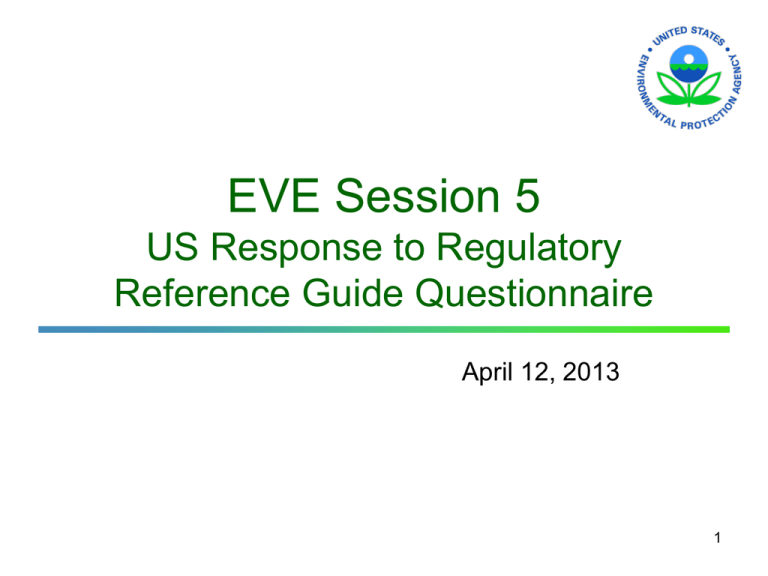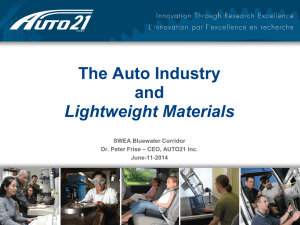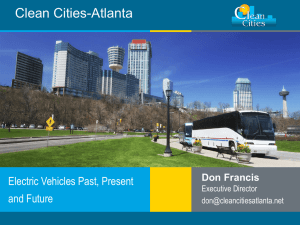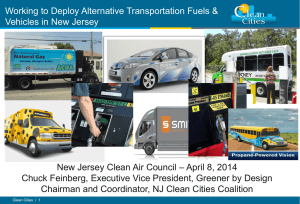EVE-05-12e
advertisement

EVE Session 5 US Response to Regulatory Reference Guide Questionnaire April 12, 2013 1 1 Overview • List of Contributors • Vehicle Attributes – – – – – – – – Range Energy Consumption/Efficiency Drive-user Information Recycling and Re-use (excluding the battery) Vehicle Labeling Battery Performance Battery Durability Batter Recycling – – – – – – – – – Battery Re-use (post mobility) On-board Charging System Off-board Charging System Wireless Charging Vehicle as an electricity supply Regulatory Incentives Financial Incentives Consumer Awareness Government Purchasing 2 Contributors to the Questionnaire • Contributors to the US response to the questionnaire include: – US Environmental Protection Agency – US Department of Energy – California Air Resources Board (CARB) • Response include – Regulations for electrified vehicles – Policy elements – Regional programs 3 Electrified Vehicle Range and Consumption • The USEPA has adopted two SAE standards for determining the fuel economy, range and energy consumption for electrified vehicles – SAE J1634 – “Electric Vehicle Energy Consumption and Range Test Procedure” – SAE J1711 – Recommended Practice for Measuring the Exhaust Emissions and Fuel Economy of Hybrid-Electric Vehicles, Including Plug-in Hybrid Vehicles • Both standards were formally adopted in the Vehicle Labeling Rule in July, 2011 4 BEV Range • The primary version of J1634 referenced by EPA is dated October, 2002 – Applies the Urban Dynamometer Driving Schedule (UDDS) and Highway Fuel Economy Drive Schedule (HFEDS) (2-cycle) to determine fuel economy and range – Test procedure requires back-to-back UDDS cycles followed by back-toback HFEDS cycles. – The range is calculated by running the cycles, adjusting for 5-cycle performance, and weighting 55/45 city and highway, respectively • Manufacturers may request the option to use J1634 dated October 2012 – The October 2012 version includes a Multi-cycle Range and Energy Consumption Test (MCT) • The MCT consist of repeated sets of UDDS, HFEDS and Constant Speed Cycle (CSC) – This is similar to the approach being proposed by the WLTP for shortening the duration of the BEV testing 5 BEV Energy Consumption/Efficiency • In addition to using J1634 to determine battery electric vehicle range, the EPA also applies J1634 to determine energy consumption. – Vehicle AC Energy Consumption = AC Energy to the Charger for Recharge / Distance Traveled – Vehicle DC Energy Consumption = DC Energy from the Battery while driving / Distance Traveled • Operated over consecutive UDDS and HFEDS cycles until the vehicle is no longer able to maintain the speed and time tolerances • Manufacturers may also request the option to use the MCT for consumption determination 6 PHEV Range • PHEV fuel economy and range is also determined using the 2-cycle requirements through application of J1711. • PHEV criteria pollutants are measured over the 5-cycle in charge sustaining (CS) mode • EPA has adopted Utility Factors (UF) for fuel economy and CO2 emissions from PHEV’s • UF’s were developed using data from the 2001 Department of Transportation “National Household Travel Survey”. – Detailed method of UF development can be found in SAE J2841. 7 Vehicle Labeling • EPA revised its vehicle labeling requirements in July, 2011 – The goal is to provide a more comprehensive fuel economy and environmental label that includes additional information regarding fuel consumption, GHG and smog-forming emissions and fuel costs or savings over a 5-year period. • All light-duty vehicles are required to be sold with fuel economy labels. • There are 7 label types: – – – – – – – Gasoline Diesel Ethanol Flex Fuel (FFV) Compressed Natural Gas (CNG) Battery Electric Vehicles (EV) Fuel Cell Vehicles (FCV) Plug-in Hybrid Electric Vehicles (PHEV) • HEV’s are covered by their engine fuel type 8 EVFuel Economy Label http://www.fueleconomy.gov/feg/label/learn-more-electric-label.shtml 9 PHEV Electric Vehicle Label 10 Fuel Economy Label Key 1. 2. 3. 4. 5. 6. 7. 8. 9. 10. 11. 12. 13. 14. Vehicle Technology and Fuel Fuel Economy Comparing Fuel Economy to Other Vehicles You Save/Spend More over 5 years Compared to Average Vehicle Fuel Consumption Rate Estimated Annual Fuel Cost Fuel Economy and Greenhouse Gas Rating CO2 Emissions Information Smog Rating Details in Fine Print QR Code Fueleconomy.gov Driving Range Charge Time 11 Battery Performance • The U.S. Advanced Battery Consortium (USABC) has established a number of test procedures for the performance of hybrid, plug-in hybrid, and electric vehicle batteries and energy storage technologies. – – – – – – Battery Test Manual for Plug-in HEVs Electric Vehicle Battery Test Procedures Manual Power Assist Battery Test Manual USABC Systems Configuration Guidelines for Batteries FreedomCAR 42 Volt Battery Test Manual FreedomCAR Ultracapacitor Test Manual • A complete description of the requirements, objectives, and goals for each Test Procedure can be found in each Test Manual. – http://www.uscar.org/guest/article_view.php?articles_id=86. 12 Regulatory Incentives (2012~2025 MY) • For the 2012~2016 GHG Rule EPA counted EV’s as 0 grams/mile CO2 • For the 2017~2025 GHG Rule, EPA established the following provision: – For EVs, PHEVs and FCVs, EPA is proposing to set a value of 0 g/mile for the tailpipe compliance value for EVs, PHEVs (electricity usage) and FCVs for MY 2017–2021, with no limit on the quantity of vehicles eligible for 0 g/mi tailpipe emissions accounting. – For MY 2022–2025, EPA is proposing that 0 g/mi only be allowed up to a per company cumulative sales cap, tiered as follows: • 600,000 vehicles for companies that sell 300,000 EV/PHEV/ FCVs in MYs 2019–2021 13 • 200,000 vehicles for all other manufacturers. Regulatory Incentives (2017~2025 MY) • To facilitate market penetration of the most advanced vehicle technologies as rapidly as possible, EPA adopted an incentive multiplier for compliance purposes for all electric vehicles (EVs), plug-in hybrid electric vehicles (PHEVs), and fuel cell vehicles (FCVs) sold in MYs 2017 through 2021. • This multiplier approach means that each EV/PHEV/FCV would count as more than one vehicle in the manufacturer’s compliance calculation (fleet average). • The multipliers for EV/FCV would be: – 2017~2019 = 2.0 – 2020 = 1.75 – 2021 = 1.5 • The multiplier for PHEV: – 2017~2019 = 1.6 – 2020 = 1.45 – 2021 = 1.3 14 Financial Incentives Federal Tax Credit Up To $7,500! Electric vehicles (EVs) purchased in or after 2010 may be eligible for a federal income tax credit of up to $7,500. The credit amount will vary based on the capacity of the battery used to fuel the vehicle. http://www.fueleconomy.gov/feg/taxevb.shtml 15 Consumer Awareness • EPA/DOT/DOE Website: www.fueleconomy.gov • Vehicle fuel economy label recently modified to provide consumers with a better understanding of electrified vehicle performance. • Depart of Energy best practices for community readiness for plug-in electric vehicles, including local financial and non-financial incentives, consumer outreach, permitting, utility development, and long-term infrastructure planning. 16 Government Purchasing • The federal government has requirements for government purchasing at both the state and federal levels. • The goals for these requirements are to reduce petroleum use and greenhouse gas emissions. • 75 percent of light-duty vehicle acquisitions must be alternative fuel vehicles. • Federal agencies can meet these requirements by purchasing plugin electric vehicles. However, Federal agencies are required to use plug-in hybrid electric vehicles (PHEVs) when they are commercially available at a reasonably comparable life cycle cost to non-PHEVs. • For more information, please see the Sustainable Federal Fleets website: https://federalfleets.energy.gov/ 17 Thank you! 18









